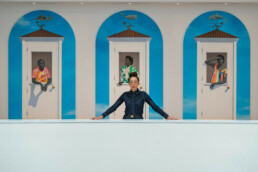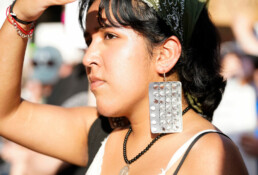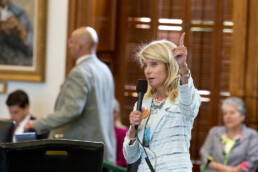The Wonder of Amy Sherald
Ordinary Black life is extraordinary in the artist’s first major mid-career museum survey.
By Rebecca Carroll
Last month, The New Yorker featured a breathtaking portrait on its cover by celebrated Black American artist Amy Sherald. First painted in 2014 and titled “Miss Everything (Unsuppressed Deliverance),” the portrait of a young Black woman wearing a bright red hat is the same piece Sherald later submitted in a competition at the National Portrait Gallery. She won the competition, which caught the attention of former First Lady Michelle Obama, who then personally chose Sherald to paint her portrait for the National Portrait Gallery—making the Georgia native the first Black woman artist to be selected for an official presidential portrait. The Obama painting changed the entire trajectory of Sherald’s career, and since then her figurative grayscale portraits have been shown in public and private collections around the world.
Now, Sherald is having her first major museum survey at The Whitney Museum of American Art, called American Sublime, a title borrowed from the poet Elizabeth Alexander’s book of the same name. I’ve known and admired Sherald for years, and I was thrilled to sit down with her to talk about her work in this truly transcendent exhibition.

Rebecca Carroll: The last time we saw each other in person was pre-Michelle Obama portrait, when we randomly ran into each other on the street in Brooklyn. And here we are today to discuss your first solo exhibition at The Whitney. How are you feeling?
Amy Sherald: I told a friend last week, “I don’t know, I just feel emotional.” And she’s like, “Well, you’re getting used to belonging to the world, and not just to yourself.” Hearing that made me want to cry, and I left her a voice text, and said, “Okay, I’m sitting here holding back tears because I am a thug and I do not like to cry. But that’s exactly what I feel like.”
It’s a lot! The show is also set against a backdrop of political turmoil in America, particularly in regards to race, and actually not dissimilar to what we were experiencing when we last saw each other. At that time, the height of Black Lives Matter, I had written a piece for the LA Times, saying “Even as we see images of what most of us already know, that police violence against Black people in America is occurring with vicious regularity, something remarkable is materializing in its wake. We are also bearing witness to a pronounced moment of Black cultural ascension.” How has your work been impacted by eras of Black cultural ascension versus centuries of Black oppression?
My work was essentially born out of the desire to free myself from a history of oppression, but also in celebration of these eras of enlightenment. What I want the viewer to experience, and I say this in the exhibition [statement], is “the wonder of what it is to be a Black person.” I’m no longer religious, but I speak about this in that language of flesh and spirit—because part of us always has to be activated [in fighting oppression].
Right, exactly. I know you consider yourself as much a storyteller as an artist. As Black storytellers, I feel like we never make anything without parts of each other within us—intergenerationally, ancestrally, futuristically. But when the work goes out into the world and starts to belong to non-Black people, I sometimes feel these waves of protectiveness about it. Do you ever feel that way about your work?
I want the work to belong in the world because it was the only way that I could figure out how to counter whiteness, and the way that everything is saturated with it, comes from it, and evolves around it. My response to that is to make something that’s just as universal, and that can be consumed in the same way, because then [white people] are going to be consuming it in the same way that I had to consume Barbie, and all of these other things.
A pointed example for me was when your portrait of Breonna Taylor was on the cover of Vanity Fair, and it felt so unjust to me that suddenly white people were allowed to look at her in this way that we had seen her all along. Did you feel any conflict about that specific piece?
I didn’t, because of how it started. It started with Ta-Nehisi [Coates], and I trusted him and his vision. Maybe if the call had come from somebody else, then yes, but because it was Ta-Nehisi, no.
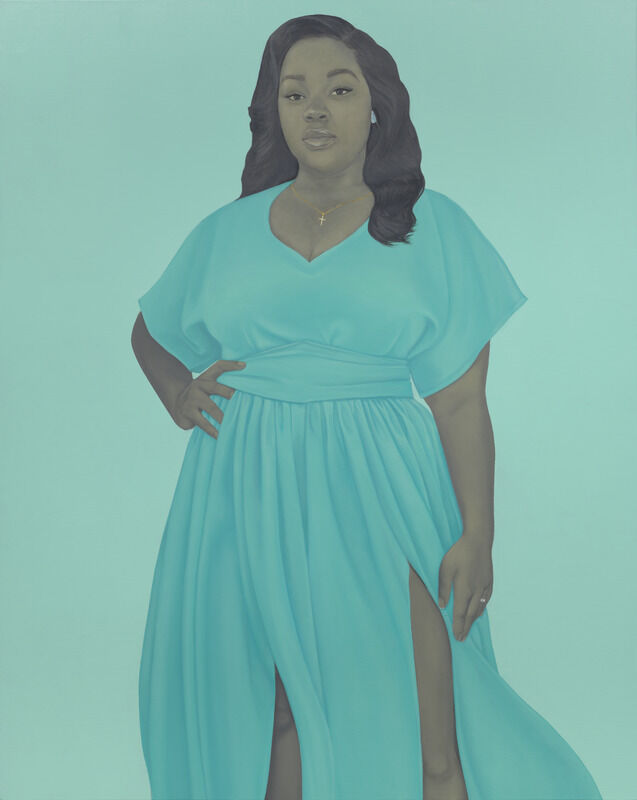
To clarify for our readers, Coates was the guest editor for that particular issue of Vanity Fair, and so that makes a difference, for sure. Now that the portrait is part of this exhibition at The Whitney, what has been the broader response to it?
A lot of people, of all races, are moved to tears by it. After I first finished it, I was really just thinking about how I’ve made this portrait, we’ve photographed it, it’s been on the cover of Vanity Fair, and now it’s in my studio. Now what can it do? I started some conversations, and it ended up being acquired by the National Museum of African American History and Culture. And now there’s a Breonna Taylor Legacy Fellowship and Breonna Taylor Legacy Scholarships for undergraduate students and law school students [at the University of Louisville, in Louisville, Kentucky, where Taylor lived; the fellowships are funded by proceeds from the portrait’s sale]. So if a student is doing anything in regards to social justice, whether their major is political science or art, they have an opportunity to get this scholarship. And then if a student is in law school and wants to work expungement [when a criminal record is erased or made unavailable for public access] cases in Alabama, which pays nothing, then here’s $12,000 to get you through your summer.
Does the idea that Black artists do work for each other resonate with you?
I feel like we make what we make because we are who we are. My mom told me this story about myself, and it stuck with me because I think my work sits in the world in the same way. [When I was a child] sometimes when we had dinner, I would just randomly get up and walk around the table and touch everybody on their shoulder and say, “I love you.” I would go all the way around, and then come sit down and finish my dinner. I think these portraits are “I love yous” out in the world to affirm anybody who is willing to see past the exterior and go deeper into their experience of what it means to be a human.
I love that story. And what do you experience when you look at your work?
I feel like the work sits in The Whitney, and there are words on the wall that explain it, but that work is me—somebody who was once a people pleaser and had a problem saying no, someone who doesn't like conflict or confrontation. My personality made that work.
I would never have looked at your work and thought, “These pieces were made by someone who had a problem saying no.” Are there specific things in the pieces that signal that to you?
I guess that’s where the beauty comes from, because the work doesn’t yell at you. It speaks to you nicely. If you feel uncomfortable in the presence of a Black person, this work will make you think, “Okay, well, maybe I don’t need to grab my purse. I might feel safe in the elevator with this guy.” It speaks to people that way. I went to Catholic school from K through 12, and was always one of two or three Black kids, so I have a lot of patience. I learned a lot of, “Let me explain to you why you can't say that.” Versus my friends that went to all-Black high schools, where it’s just like [gestures taking her earrings off], “Let me tell you…”
But you feel differently now, right? You’re in a different place. How do you think that will affect your work moving forward?
I’m not sure how the work is going to evolve to match who I am now, which is somebody who’s stronger, who doesn't mind saying no, and will look at you while you feel uncomfortable with my answer. I am excited because everything that I’ve made in this show has been living in my head for 20 years.
Does it feel like a kind of excavation in that way?
It feels more like a birth than an excavation. When I think about Black American art history and just our legacy within the larger canon, I feel like we don’t or can’t function on the same timeline as everybody else. It still feels like the beginning of something, this moment of myself, Rashid Johnson, Lorna Simpson, and Jack Whitten [all currently having museum shows]. It feels really great despite everything that’s happening. The art world is representing the world that we want to be—the real world right now.
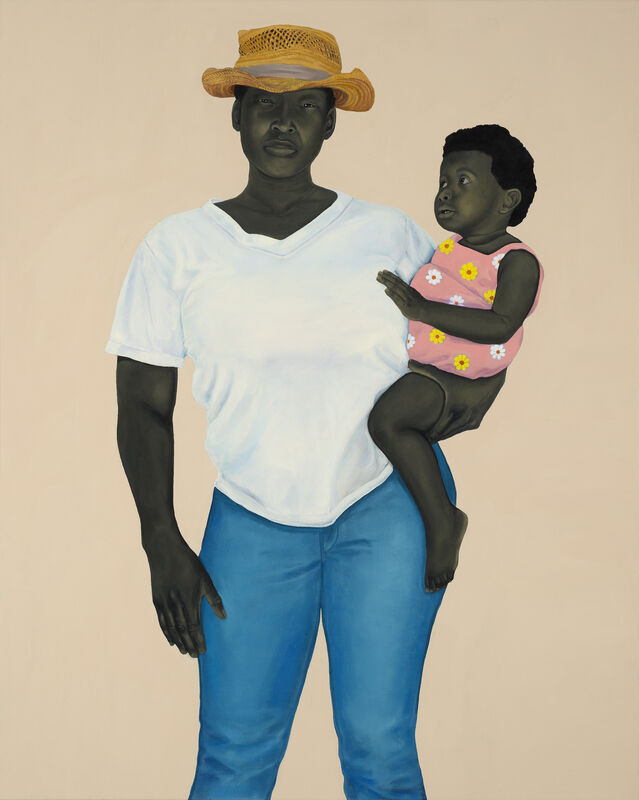
What happens next for you?
I’m hoping that this show will make it into the National Portrait Gallery without having to make any compromises based on who’s sitting in an office at the White House. And I don’t mean, “Well, if I can’t have this painting of two men kissing and a trans person, then I’m not going to do the show.” I feel like that would be a mistake. I feel like it’s a mistake to step down from boards just because [Trump] wants to take over the Kennedy Center. Now more than ever, I feel like it’s important we be in those rooms and not shutting down the conversation. I think the bigger moment would be the work being in the Smithsonian Institution and people coming there to look at American history and Presidents, and then walking into my exhibition.
Whatever the fate of the work in this show, one of the things that really came through as I was walking through the exhibit, just like the way you used to walk around your family’s dinner table and tell everybody you love them—all of these people are taking care of each other, and I felt tapped on the shoulder and loved by every one of them.
Exactly as you should have felt.
Why Is Consent Controversial?
 April 24, 2025 Howdy, Meteor readers, I know everyone is talking about Sinners, but I am what you would call a certified scaredy-cat; I still suffer from Scream. But a bunch of fellow scaredies online say it’s not too bad if you watch it during the day so I’ll see y’all at the afternoon matinee.  In today’s newsletter, we investigate sex miseducation in Indiana. Plus, Nona Willis Aronowitz remembers her “feminist fairy godmother.” Meow, Shannon Melero  WHAT'S GOING ONVirginity education: Yesterday, Indiana’s House and Senate voted in favor of SB 442, titled “Instruction on Human Sexuality.” You might have heard of it (on our Instagram feed and elsewhere) because of a debate over whether that “instruction” should include the idea of consent. The bill’s author, Sen. Gary Byrne (R-IN), had removed a requirement that teachers address consent earlier this week, arguing that the subject could be seen as “controversial.” (Research from the Indiana Department of Health shows that 56 percent of sexually active high schoolers had experienced some form of sexual violence, with 11th grade girls making up most of that group.) After public outcry, though, the consent requirement was re-added to the bill yesterday—your latest reminder that yelling works. But here’s the thing: The bill is still light on the education part of sex education. In addition to consent, it requires sex-ed classes in Indiana to teach four things: abstinence, abstinence (yes it’s listed twice), instruction that the best way to avoid STIs is a “mutually faithful monogamous relationship in the context of marriage” (we remind you, these are children and teens), and the viewing of a high-definition ultrasound video, at least three minutes long, depicting the development of organs in a fetus. It’s giving Catholic-school health class, and I would know, as someone whose sex-ed was having to watch the movie Riding in Cars with Boys. Let’s linger on the video for a second. These kinds of videos—most notably the notorious “Baby Olivia”—have cropped up over the last two years as a tool of the anti-abortion movement and are more often than not, medically inaccurate and meant to elicit an emotional response rather than be strictly educational. When pressed about the video requirements by Democratic senators yesterday, Byrne insisted he was not specifically suggesting “Baby Olivia,” IndyStar reported, and that school boards would be able to choose which films get shown to students. “There’s plenty of examples of videos,” he argued. (When pressed to name them, he could not.) Indiana is, of course, not the first state to introduce such narrow requirements for sex-ed classes or to inject what sound like conservative Christian views of sex into a secular public school system. Currently, 37 states have laws that require abstinence as part of sex education, while only 18 require teachers to share information about birth control. As far as education around consent? Only 12 states—13 if the Indiana bill passes—require that it be mentioned. But studies show that simply telling teenagers not to have sex doesn’t protect them from STIs or unwanted pregnancies. What does work, according to the Sexuality Information and Education Council of the United States, is comprehensive education that includes consent, contraception, STI prevention, and sexual health for LGBTQ+ communities. AND:
 OBAMA AT A LIVE TAPING FOR HER PODCAST, "IMO." IN HER LEFT HAND, SHE CAN BE SEEN HOLDING ALL OF HER DESIRE TO CONTINUE BEING A PEOPLE PLEASER. (VIA GETTY IMAGES)
 DURBIN IN 1994. (VIA GETTY IMAGES)  WEEKEND READING 📚Online: When we said we wanted a “womanosphere” this is not what we meant. (The Guardian) On history repeating itself: Historian Greg Grandin explores Latin America’s journey from “fighting to facilitating fascism.” (Democracy Now) On mixtapes: Have a cry with writer Jill Mapes, her dad, and a shared appreciation for good music. (Hearing Things)  FOLLOW THE METEOR Thank you for reading The Meteor! Got this from a friend?
|
![]()
You Can't Pay Us to Have More Kids
 April 22, 2025 Greetings, Meteor readers, It’s Earth Day! And also, it’s Taurus season! May we all feel some stabilizing, comforting energy over the next few weeks because boy, do we need it. In today’s newsletter, Nona Willis Aronowitz explains what’s behind the administration’s “make more babies” plan. Plus, we bid farewell to the pope. Bulls up, Shannon Melero  WHAT'S GOING ONBaby bust: Yesterday, the New York Times reported that the pro-natalist Trump administration, concerned about the U.S.’s falling birth rate, has been brainstorming ways to get American women to have more children. Some of their ideas include five-thousand-dollar baby bonuses, menstrual-cycle education, and a National Medal of Motherhood (a tactic you might recognize from the Nazis). Notably missing: plans to subsidize childcare, parental leave, or any other crucial improvements actual families have been requesting for generations. Lots of incredulous reactions across the internet made that exact point: “How can you expect us to have more babies without a strong social safety net?” As someone who yearns for free daycare and paid maternity leave, I’m tempted to say the same. Yes, it’s darkly ironic that the Trump administration is calling for more babies even as it has made deep cuts to maternal and child health and opposed any repair of the U.S.’s woefully inadequate family policies. But the thing is, offering benefits to families doesn’t actually boost birth rates. In fact, many countries that provide robust support for parents, like Finland, Norway, and Germany, have birth rates below ours. There’s no evidence that Trump’s proposed policies would work, either. “Even the richest, savviest, most committed governments” are stumped, a history professor told Vox in 2023. “If such policies were discoverable, I think someone would have discovered them.” So the question you’re probably wondering is: What’s so bad about the birth rate falling? Most countries in the world are now below the “replacement rate” of 2.1, and the trend is most pronounced in the richest nations; the United States is at about 1.6, a drop of more than 20 percent in the last decade. Seen one way, fewer babies is a success story of women truly having control over their own lives, and—thanks to contraception access, education, and career opportunities—being able to make choices that may or may not involve children. Maybe those decisions “shouldn’t scare us,” writes feminist writer Jill Filipovic, “but should inform us that when women have more options and opportunities, women’s desires become far more varied.” Still, experts across the political spectrum agree that a shrinking population with more old people than young presents huge economic and humanitarian challenges. An aging society means fewer workers to keep society functioning—to grow our food, to build our houses, to care for the elderly. For many, the story of South Korea, which has the lowest birth rate in the world, provides a disconcerting glimpse of what happens when so few babies are born: 1 in 5 people in South Korea are over 65, and nearly 40 percent of those elders live in poverty. But no matter how valid these concerns are, Trump’s “solutions” are both demeaning (ugh, that medal) and historically familiar: The one way governments have temporarily bumped up birth rates throughout history is by oppressing women. Think Nazi Germany and its Lebensborn program, which used women as incubators for 20,000 “Aryan” babies. Or Ceausescu's Romania, which severely restricted abortion and birth control access to devastating effect. Even our own “baby boom” in the repressive 1950s partially relied on pushing women into domesticity. This brand of pro-natalism—promoted by people like J.D. Vance, Tucker Carlson, and Elon Musk—often goes hand-in-hand with racism and anti-immigrant sentiment. While immigration is often touted as a short-term solution to the U.S.’s low birth rate, the Trump administration’s cocktail of natalism and xenophobia makes clear that they don’t want more babies of all kinds, just white, Christian babies in heterosexual nuclear families. So, yes, I agree that we should seriously grapple with how to reshape society in the face of population decline. I just don’t trust this administration—with its blatant disregard for families and basic human decency—to do it. —Nona Willis Aronowitz AND:
 POPE FRANCIS DELIVERED HIS FINAL EASTER SERMON AT THE VATICAN THE DAY BEFORE HE DIED. VIA GETTY IMAGES
 COLUMBIA STUDENTS AND ALUMNI CHAINED THEMSELVES TO THE UNIVERSITY'S MAIN GATE LAST WEEK TO PROTEST THE DETENTION OF STUDENTS. (VIA GETTY IMAGES)
 FOLLOW THE METEOR Thank you for reading The Meteor! Got this from a friend?
|
![]()
The New Binge Drinkers
 April 17, 2025 Dearest Meteor readers, I’m feeling tender this week and I’m gonna blame Dying For Sex, the new FX miniseries about actual death, the little death, and ride-or-die friendship. The final episode had me in a puddle the other day. Highly rec’d if you’re a fan of Michelle Williams and/or catharsis.  Today, we dig into a surprising new statistic about young women and drinking. Plus, affirmative action for white men and justice for Black mothers. Still sniffling, Nona Willis Aronowitz  WHAT'S GOING ONA sobering new study: If your image of a young binge-drinker is a frat boy doing keg stands, you’re out of date, according to a new analysis in the Journal of the American Medical Association. While drinking among young people is declining overall and older women still drink less than older men, women ages 18 to 25 now binge-drink slightly more than their male counterparts. (Binge-drinking is defined as regularly having more than four drinks in one sitting for women and more than five drinks for men; the study compared data from the National Survey on Drug Use and Health between 2017-2019 and 2021-2023.) Women’s drinking habits have been catching up to men’s for decades, and scholars, journalists, and public health advocates have been noting the results: Women are increasingly dying, getting sick, and going to the ER from drinking. And why are we drinking more? It’s partly because of stress. (Research indeed shows that women are more likely to drink in order to cope than men. See also: “Mommy wine culture.”) The pandemic seems to have compounded the problem; articles and studies have abounded since 2020 showing how much more women were drinking to get through their days. Women, some have concluded, “need an intervention.” (Others, as one Meteor commenter put it a few months back, are “tired of being targeted for all the things.”) But what accounts for younger women binge-drinking more than younger men? The study was careful not to draw conclusions; the authors say that because the groups analyzed in each time period are not the same people, they don’t know whether we’re seeing an actual rise among young women or, perhaps, a decline among men. But Susan Stewart, a professor of sociology at Iowa State University who studies alcohol use among women, has an initial hypothesis: “I think it has to do with women’s independence,” she says. “Young people are dating and having sex at lower rates, and less interested in serious relationships. Women are doing their own thing, which includes partying.” Stewart also points out that young women have higher rates of college completion than men, and college students binge-drink more than their non-college peers. It’s too early to tell whether this will be a longterm trend, Stewart says, but it could just be a side effect of an otherwise encouraging phenomenon: “women exercising a greater latitude of freedom.” In any case, it doesn’t hurt to familiarize yourself with the most recent health guidelines on drinking. And yes, alcohol can be a source of great pleasure—but in case you are struggling, there’s help to be had. AND:
 THE TRANS RIGHTS MOVEMENT IN SCOTLAND HAS BEEN FIGHTING FOR YEARS. VIA GETTY IMAGES
 WEEKEND READING 📚On the bigger picture: The CEO of the Society for Women’s Health Research breaks down exactly how Trump-era NIH cuts will affect women’s health. (XX Factor) On the man at the center of a crisis: Here’s what to know about Kilmar Ábrego García, the Maryland man unjustly trapped in a notorious prison in El Salvador. (The Guardian) On playing the game: Fox Sports host Joy Taylor talks to Irin Carmon about work, beauty, and those sexual harassment lawsuits. (The Cut)  FOLLOW THE METEOR Thank you for reading The Meteor! Got this from a friend?
|
![]()
The Secret War on Birth Control
 April 15, 2025 Hello, sweet Meteor readers, Happy Tax Day! This year I learned about the Child and Dependent Care Tax Credit, which sounded heavenly given that my family spent fully $15,000 on daycare last year. Imagine my disappointment when I found out that the maximum credit you can claim is 20% of $3,000…i.e. $600. Womp womp. (And Republicans have contemplated dropping even this piddling credit.) The state of childcare in this country is enraging. Today, we’re tracking the sneaky, scary erosion of birth control rights in America. Plus, Harvey Weinstein is back in court, and the “broligarchy” gets a dressing-down. Nona Willis Aronowitz  WHAT'S GOING ONThe secret war on birth control: From the moment the high court overturned Roe v. Wade in 2022, one Supreme Court justice signaled that birth control access was in danger. In a concurring opinion back then, Justice Clarence Thomas urged the court to re-examine “demonstrably erroneous decisions” like Griswold v. Connecticut, the 1965 ruling which granted Americans a constitutional right to birth control. So what’s happened to birth control since that fateful ruling? Last week, the National Women’s Law Center released a report addressing that question, and it finds that our right to contraception is indeed eroding. Since 2022, some lawmakers have wasted no time proposing or musing about bans on some forms of birth control; a nominee for Michigan attorney general compared emergency contraception to fentanyl. But there’s one big obstacle in their way: Birth control is incredibly popular. Upward of 90% of Americans believe it should be legal. So policymakers have turned to less obvious tactics to restrict contraception.  BIRTH CONTROL PILLS SHOULD BE AS CONTROVERSIAL AS DANGLY EARRINGS. VIA GETTY IMAGESLawmakers “know that they can’t attack birth control publicly or on paper, so they’re doing it secretly,” said Kimi Chernoby, senior counsel for reproductive rights and health at the National Women’s Law Center and the primary author of the report. Chernoby pointed to an innocuous-sounding bill called the Medical Ethics Defense Act, passed just last week in the Tennessee Senate that has a good chance of passing the House, given that a subcommittee already approved it. Not once does it mention birth control. But the legislator who sponsored the bill later said in an interview that the law would allow pharmacists to refuse to fill prescriptions for birth control. This sneakiness can reach the point of absurdity: Texas senator Bryan Hughes, the guy who crafted the state’s abortion ban, just presented a bill that would test wastewater for abortion medication and hormones found in birth control, because of the supposed health risk it poses “especially for pregnant women and children.” Oh, the irony. And to avoid political blowback, birth control opponents are also going after people on the margins, namely teens (by introducing parental consent laws for birth control) and low-income people (by restricting Title X and Medicaid recipients’ access to contraception). It’s a strategy the report calls “the anti-abortion playbook” because it mirrors anti-abortion activists’ journey from Roe to Dobbs: Start by targeting people who hold less political clout, and inch toward the mainstream from there. They’re also focusing on certain kinds of birth control like emergency contraception, which has been endlessly (and erroneously) attacked by rightwing lawmakers and institutions as a form of abortion, despite the FDA’s explicit clarification in 2022. “Some people are making a conscious decision not to listen to science,” Chernoby said.  CONGRESS TRYING (AND FAILING) TO PROTECT THE RIGHT TO CONTRACEPTION IN 2022. VIA GETTY IMAGESSo what can you do? Since this erosion is mostly on the local and state level for now, Chernoby suggests reaching out to state legislators urging them to codify protections to birth control, which a handful of states have done in the wake of Roe’s fall (and Thomas’ warning). Be sure to call your representatives if you live in Alabama, Arizona, Florida, Georgia, Iowa, Louisiana, Mississippi, North Carolina, Tennessee, and Wisconsin—all states that have blocked attempts to pass a Right to Contraception Act in the past. And if lawmakers don’t listen, make your outrage known. Chernoby said that when these issues get widespread coverage, restrictions often get reversed. For instance, in 2023, Iowa’s attorney general paused payments to hundreds of sexual assault victims for the emergency contraceptive Plan B. But she backed down after an outcry from Democrats and reproductive rights advocates, who pointed out that paying for pregnancy prevention should be the last thing survivors have to worry about. “When these attacks start happening more in the open,” Chernoby said (and she thinks they eventually will), “I predict there will be a lot of resistance.” Let’s make sure she’s right. AND:

  FOLLOW THE METEOR Thank you for reading The Meteor! Got this from a friend?
|
![]()
You Can Live Here, Until You Can't
 April 10, 2025 Greetings, Meteor readers, I never want to hear, read, or write about tariffs ever again. The whiplash is exhausting. In today’s newsletter, we connect the dots on the administration’s attacks against immigrants. Plus, the SAVE Act shows signs of life. He’s coming for our cheese, Shannon Melero  WHAT'S GOING ONWho gets to live here?: “I don’t understand why you’re so worried—you can’t be deported,” is a statement I’ve heard from several people since I started covering Trump’s mass deportation plans—plans which have seen more than 300 student visas revoked, about a dozen legal U.S. residents imprisoned, at least seven U.S. citizens detained (one apparently for legally representing a student protester), and one Maryland man deported. In the city where I live, ICE has carried out raids that have led to veterans being arrested without cause. And now, just two days ago, White House Press Secretary Karoline Leavitt confirmed that the Trump administration is looking into policies that would allow for the deportation of incarcerated U.S. citizens. This would be, of course, utterly illegal because of the Eighth Amendment; as one expert told Truthout, “There’s not even a hint of a possible way to do it under any circumstances whatsoever.”  MEMBERS OF THE HISPANIC CAUCUS HOLD UP IMAGES OF KILMAR ABREGO GARCIA, THE MARYLAND WHO WAS "MISTAKENLY" DEPORTED TO EL SALVADOR. (VIA GETTY IMAGES) But it was also illegal to deny due process, until it wasn’t. It was illegal to detain someone without a warrant and probable cause, until it wasn’t. There’s one thing you can say about the Trump administration: They’re resourceful. Whether by hook, crook, executive order, skirting the courts, or resurrecting wartime laws, this administration has proven it won’t be deterred by the legal process. Ostensibly, the judicial system should be able to protect the vulnerable—and some have been spared—but it simply isn’t happening fast enough for those currently sitting behind bars in Louisiana, Goshen, New York City, and El Salvador. In other words, this fear is not baseless. What I see in front of me is not a collection of disconnected arrests and deportations; I see the slow, carefully curated removal of people of color—especially outspoken ones—from the United States. People like my late father and my brothers who would meet Trump’s stated criteria for detention (criteria I will not specify because I’m not a snitch). People like my best friend, a woman well-known for speaking up for Palestinians on social media. People like my neighbors, many of whom are immigrants. What good is anyone’s perceived safety if the people who make living here worth it aren’t safe as well? The administration is making clear that it wants to paint protestors and people of color as an enemy—they’re literally deporting people under the Alien Enemies Act—but you’re the one who gets to decide who your enemies are and it’s not the protestor, or the Venezuelan dad, or the troubled teen. It’s probably just Deb, in accounting. AND:
 I AM SO GLAD MY HUSBAND IS NOT A LEBRON FAN BECAUSE I'M NOT SPENDING $75 ON THIS. LOOKS GREAT THOUGH. (VIA MATTELL)
 DOLORES HUERTA AND PRESIDENT OF THE AMAZON LABOR UNION CHRISTIAN SMALLS AT THE METEOR'S 22 FOR '22: VISIONS FOR A FEMINIST FUTURE. (VIA GETTY)  WEEKEND READING 📚On girls’ rights: School-aged girls across East Africa are being kicked out of school after forced pregnancy tests. (Teen Vogue) On being untethered: What would a woman’s life look like disconnected from the relationships that so often define it? Novelists are trying to imagine. (The Atlantic) On co-opting feminism: How the French far-right uses the language of women’s rights to demonize immigrants. (The Baffler)  FOLLOW THE METEOR Thank you for reading The Meteor! Got this from a friend?
|
![]()
Death By 10,000 Layoffs
  April 8, 2025 Greetings, Meteor readers, Congratulations to newly crowned NCAA champions the Florida Gators and UConn Huskies. But more importantly, congratulations to me for winning my first bracket pool ever! It only took three years 🥴. In today’s newsletter, we look at the woman-specific impact of layoffs at the Department of Health and Human Services. Plus, we’re all still thinking about The White Lotus. Shannon Melero 🏆  WHAT'S GOING ONDeath by (ten) thousand layoffs: Last week the Trump administration decimated the Department of Health and Human Services; in the words of one former employee, “shitshow is an understatement.” As a result, the organizations housed under HHS—the Center for Disease Control, National Institutes of Health, Food and Drug Administration, and the Centers for Medicare and Medicaid— lost 10,000 staff members, effectively shuttering a number of departments. But not just any departments; the cuts will roll back decades of hard-won progress on women’s health research. Just take a look at what we’ve lost: Most of the CDC’s Division of Reproductive Health was laid off, including the team responsible for updating contraception guidelines and groups researching IVF and fertility clinics’ success rates (despite Trump’s promises to make the procedure more accessible). Three of the four branches of the Division of Violence Prevention were also eliminated. The division, established three decades ago, was crucial to framing violence as a public health problem, and yet last week, on the first day of Sexual Assault Awareness Month, all of the staff working on intimate partner violence prevention and sexual assault prevention programs were dismissed. The administration also fired all of the CDC scientists researching drug-resistant STIs. As is usually the case, these cuts will disproportionately impact Black, Latine, and lower-income women. The entire team working on the Pregnancy Risk Assessment Monitoring System, a project started in 1987 to reduce infant morbidity and mortality by offering maternal health guidance through the entire birth process, was laid off last week. “Black women in America are three times more likely to die from pregnancy-related causes than white women,” one expert told Rolling Stone, and “we know this in large part because of the data collected and analyzed by the CDC.” And the timing of the system’s shutdown couldn’t be worse, a public health professor explained to Mother Jones: It “jeopardizes women and infants’ health at a time when maternal mortality rates in the US have been rising and access to maternity care is increasingly difficult.” So what happens next and how can you help? Lawyers contend that many of the layoffs are on “shaky legal ground”; some state attorneys general have sued to block them. If your state hasn’t joined the lawsuit, file a complaint with your AG’s office online and ask them to fight back against these layoffs. If there is a local domestic violence shelter or rape crisis center in your area, it’s a great time to call them and ask exactly what they need. The government may not care, but we still can. AND:
 MY CHILD'S FAVORITE COUPLE, MS. RACHEL AND HER HUSBAND MR. ARON. (VIA GETTY IMAGES)
 FOLLOW THE METEOR Thank you for reading The Meteor! Got this from a friend?
|
![]()
Lessons from an epic 2013 filibuster
 April 3, 2025 Dearest Meteor readers, I gotta say I’m looking forward to this weekend—and not only because there’s a Hands Off! protest a mere five-minute drive from my upstate New York home, which NEVER happens (find the closest event to you here). A friend is also throwing a White Lotus finale party, and I could use a party in my life.  Today, we look back at our favorite filibuster in the wake of Cory Booker’s marathon speech. Plus, where American women have the most (and least) power, and your weekend reading. With love and tsunamis, Nona Willis Aronowitz  WHAT'S GOING ONThe art of the filibuster: Sen. Cory Booker broke a Senate record earlier this week when he spoke on the floor for more than 25 hours to protest the actions of the Trump administration. Without taking a bathroom break or even sitting down, he addressed an array of issues, from Elon Musk’s government takeover to tax cuts for the rich. Underneath the livestreams on YouTube and TikTok, encouraging comments whizzed by at breakneck speed. Was it political theater, a stunt? Absolutely (and maybe that’s a good thing). Could it actually do something? Depends on how you look at it. Unlike a traditional filibuster, Booker wasn’t trying to hold up particular legislation; rather, he was there, as he put it, “disrupting the normal business of the United States Senate.” And even true filibusters don’t have a great record of halting the laws they’re protesting. Sen. Strom Thurmond, a segregationist who held the previous record of longest speech in the Senate by filibustering the Civil Rights Act in 1957, failed to block the historic legislation. “I’m here despite his speech,” Booker noted. The more recent filibusters of Sen. Chris Murphy and Sen. Ted Cruz didn’t kill any laws, either. What highly publicized marathon speeches like filibusters can do, however, is drum up energy, draw focus, and create symbols that inspire tangible action. Take the case of Wendy Davis, the first filibuster I personally remember watching. In 2013, the then-Texas State Senator held an 11-hour-long filibuster to block SB5, an omnibus abortion bill that, among other restrictions, banned abortion after 20 weeks in the state and required that abortion providers have admitting privileges to nearby hospitals. (Sounds quaint now, but these laws really were canaries in the coal mines.) Flanked by abortion rights supporters who one Republican called an “unruly mob,” Davis and the Democrats managed to run out the clock past midnight, preventing SB5 from being signed into law.  WENDY DAVIS IN THE EARLY HOURS OF HER 2013 FILIBUSTER. (VIA GETTY IMAGES)It was an electric moment in politics and feminism. Davis—a telegenic lawmaker with a powerful backstory who, the internet noted at the time, bore a striking resemblance to Friday Night Lights’ Tami Taylor—became an instant icon of reproductive freedom. Even the pink running shoes she wore during her filibuster got famous. For a while, Davis was the toast of national Democrats, not to mention a then-thriving feminist blogosphere. We all know how this story ends: Wendy Davis’ unforgettable stand did not stop the anti-abortion movement. The Texas abortion bill eventually passed in the form of HB2—and although the Supreme Court struck down that law in 2016, it would later overturn the constitutional right to abortion in 2022. For her part, Davis ran for governor in 2014 and lost badly. And yet, Davis’ filibuster made its mark. It inspired women to run for office, get involved in politics in her state, and start new abortion funds. From all the way in New York, I became aware of red-state movements to protect abortion in a way I wasn’t before. Meanwhile, I am no fan of Booker’s, but even I have to admit that his speech lifted my mood. I was impressed by his stamina; I spent more time than I’d like to admit looking into the, um, physiology of it all. Will those rah-rah comments under the livestreams translate into action? Into mutual aid, into more public refusals, into other members of Congress disrupting Trump’s plans, into some of us running to replace them if they don’t? I sure hope so. AND:
 AN ACTIVIST MAKES THE VULVA SYMBOL DURING THE 2023 PROTESTS IN TURIN. (VIA GETTY IMAGES)
 Three Questions About…PowerWhere women have the most (and least) of it, from a new study by Dr. C. Nicole MasonBY SHANNON MELERO  Last month, the new initiative Future Forward Women published its first U.S. Women’s Power and Influence Index, a state-by-state breakdown of where women have the most and least overall power—as measured by education, economic status, political inclusion, and a dozen more key indicators. The report found that Alabama is the lowest-ranking state, with women wielding the least overall power there, and the highest-ranking isn’t even a state—it’s the District of Columbia. We asked Future Forward Women president Dr. C. Nicole Mason three questions about what it all means. First, how did you define“power” for this research?For me, “power” is the ability to influence or direct the actions of a group or society toward a specific desired outcome. I started with the premise that although women are 50 percent of the U.S. population, we are still the most likely to live in poverty, to experience sexual harassment or gender-based violence, and to live in states where we don’t have complete bodily autonomy. Politically, we hold less than a third of elected offices. I wanted to understand why—and the why for me was power; we don’t have enough of it. Or at least not enough to…pass common-sense laws and policies that would make our lives better. In our society, it’s not okay for women to say they want power—but that’s what we need, especially right now. Which finding surprised you the most?The states of Florida and Texas ranked third and fourth in terms of women's political power and influence [but ranked 25th and 45th, respectively, in terms of the overall power women wield]. What we observed is that even though both Texas and Florida have high numbers of women in their state legislatures, Congress, and executive leadership positions, that’s not enough. Yes, we want women in political office, but these women and men must support policies favorable to women and families. Washington, DC, ranked number one in the index because DC has the highest median earnings for women in the nation, along with high levels of education. However, across all states, without exception, women of color are not doing as well as their white counterparts. For example, in the District of Columbia, the poverty rates for Black women are notably high. There is not a single state where women of color are faring [just as] well or better than other women. What are the most important takeaways from the report?We need to decide that it’s not okay for state borders to determine the rights that women have or don’t have in this country. It wasn’t okay 400 years ago and is not okay now. For new models and inspiration, we should look to other countries’ universal childcare, paid sick and family leave, reproductive freedom — [and ones] that have faced similar threats to democracy and the erosion of rights. We should also go to the states where women have the least power and influence. Not going to those states will cost us because they become the testing ground for bad policies. Living in a high-power state will not protect you. We are in this together. Lastly, we need to have radical imaginations, dream big, and say what we want out loud to inspire others to join us. We need everyone, in their own way, to help us win big.  WEEKEND READING 📚On history’s “quiet moments”: Presidential historian Alexis Coe looks back at Lyndon B. Johnson’s hire of Geri Whittington, the first Black woman to be a president’s secretary and a “testament to his administration's complex, often contradictory, yet unwavering commitment to racial equality.” (Harper’s Bazaar) On sex and death: A tantalizing profile by thee Rachel Handler of Michelle Williams, who stars in a new FX show, Dying for Sex, about a terminal cancer patient’s last-ditch sexual odyssey. (Vulture) On grief and care: Years ago, Houston-based Black midwife DeShaun Desrosiers experienced a traumatic birth. She’s now on a mission to train doulas of color in her community. (Houston Landing)  FOLLOW THE METEOR Thank you for reading The Meteor! Got this from a friend?
|
![]()
Good abortion news out of...Alabama?
 April 1, 2025 Greetings, Meteor readers, The women’s Final Four is set, and thankfully for my bracket, UConn is still in it along with UCLA, Texas, and South Carolina. As much as I love Dawn Staley, I need anyone but South Carolina to win as I refuse to lose to my own husband in our bracket battle. 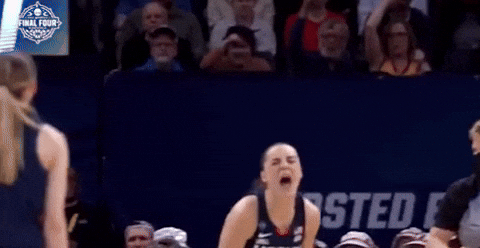 In today’s newsletter, we celebrate a win for abortion in Alabama. Plus, one very expensive election and an answer to whether or not your basketball tattoo can get you arrested (it can). Cheering for Paige, Shannon Melero  WHAT'S GOING ONSometimes we win: On Monday, a federal judge in Alabama ruled that the state could not prosecute people for obtaining abortions in states where the procedure is legal, writing in his decision that “Alabama’s criminal jurisdiction does not reach beyond its borders.” (Someone tell that to Ken Paxton.) The judge also wrote that going after people or organizations who help others get abortions “would violate both the First Amendment and the right to travel.” The ruling comes in response to a 2023 lawsuit filed by Yellowhammer Fund, the state’s only abortion fund, along with West Alabama Women’s Center (WAWC) and Huntsville OB/GYN Dr. Yashica Robinson against the state’s attorney general Steve Marshall, who had publicly threatened to criminalize anyone aiding out-of-state abortions under a criminal conspiracy law from 1896. Even just those threats had been having real-world consequences in Alabama, where abortion is illegal in all instances with very, very few exceptions. Robin Marty, the director of operations for WAWC, told The Meteor that even after Roe was overturned, people came to the center seeking care—often unaware that abortion had become illegal. But because of Marshall’s threats to enforce anti-conspiracy laws, Marty says her staff was severely hindered from offering patients guidance on how to get an abortion, despite no new legislation being on the books. “We had to say ‘I can't help you,’” Marty tells The Meteor. “Because any information that we provided would then be potentially considered to be the beginning of that so-called criminal conspiracy.” If that kind of cruelty on top of cruelty—in which the state mistreats patients and bars anyone from helping them—sounds familiar, that’s because a number of other anti-abortion states are also manipulating existing racketeering and conspiracy laws to make it nearly impossible to access abortion care. Idaho and Tennessee have already codified so-called “abortion trafficking” laws, making it a felony to help teens get out-of-state abortions without parental consent. (Tennessee’s law is being challenged in court.) Last month, Texas, the least magical place on earth, introduced SB 2880, which would open providers, funds, and even abortion pill manufacturers up to civil suits. But the ruling in Alabama is a considerable bright spot in the fight for abortion access and could provide a legal boost to the fight against other abortion travel bans. Marty still has concerns—“the state has said that they’re looking at their options”—but, she says, “we are just excited that we are able to provide as much care as we are legally allowed to right now.” AND:
 WHEN YOU'RE TIRED BUT YOU PROMISED YOUR CONSTITUENTS YOU WOULD "STAND UP AND SAY SOMETHING" EVEN IF IT MEANT NOT GOING TO THE BATHROOM FOR A FULL DAY. (SCREENSHOT VIA YOUTUBE)  FOLLOW THE METEOR Thank you for reading The Meteor! Got this from a friend?
|
![]()
Just Let Everyone Play
Women’s leagues, men’s leagues, and an all-gender league? A new book explores the possibilities.
By Scarlett Harris
In 1902, British figure skater Madge Syers won the silver medal in what was, at the time, an all-men’s World Figure Skating Championships. Until then, women competed only in elite sports perceived as feminine, such as tennis, croquet, and horseback riding, but weren’t explicitly prohibited from competing against men, perhaps because the thought seemed so outlandish. So in 1906, the International Skating Union created the women’s category, which Syers dominated that year and the next, eventually winning gold at the 1908 Olympics.
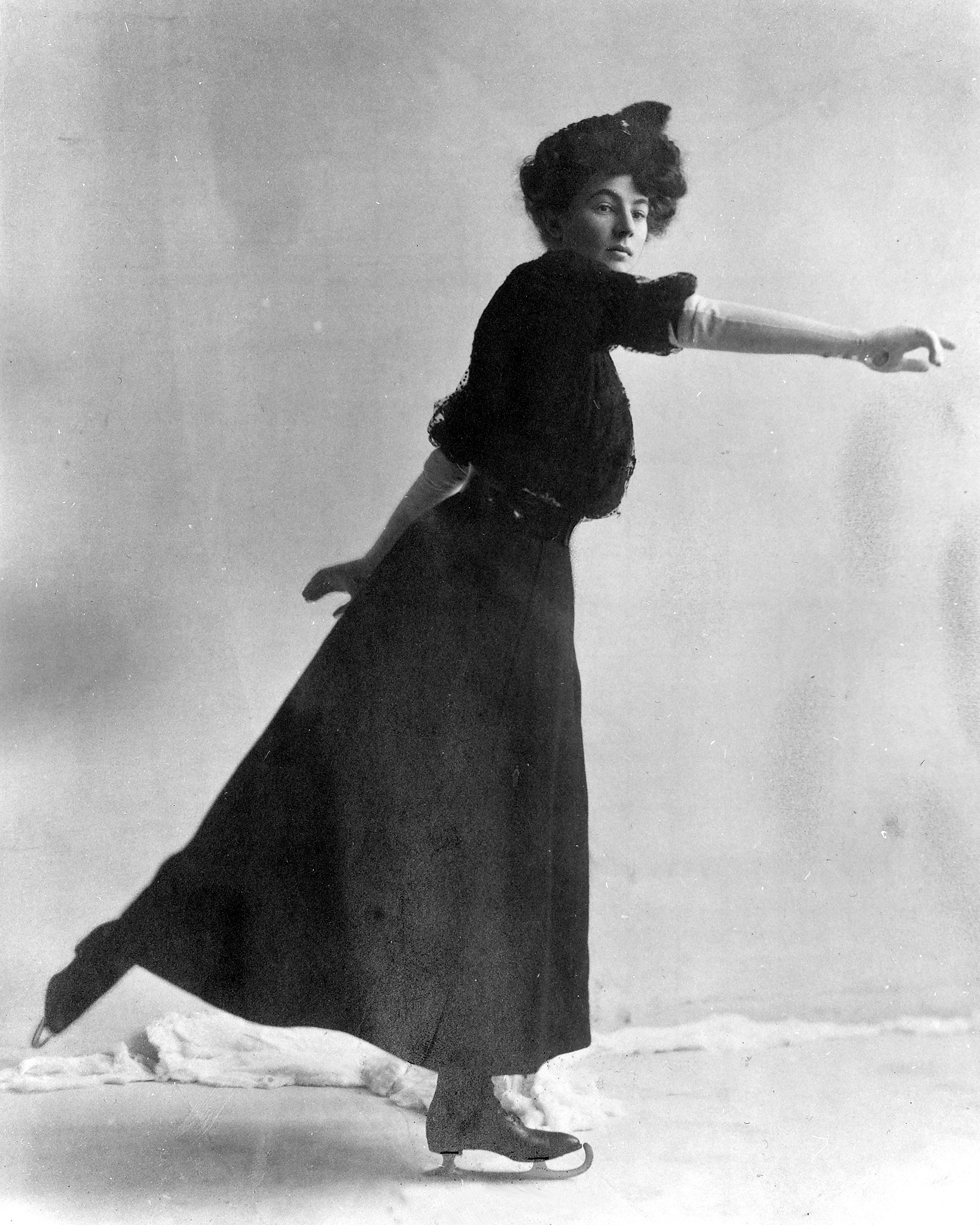
Syers is widely credited as the reason a “women’s” category in sports competition came to exist—and eventually became the highly lucrative yet highly underestimated women’s leagues of today. Women’s sports are more popular than ever, with viewership rising and even surpassing the men’s league at times, including at last year’s women’s March Madness. Athletes such as Dijonai Carrington, Angel Reese, and Caitlin Clark are now household names. Women’s soccer is the fastest-growing sport in the U.S. and a far more riveting watch than men’s. But—and stay with me here—are sex-segregated leagues the best we can do for gender equality in sports?
In Sheree Bekker and Stephen Mumford’s thought-provoking new book Open Play: The Case for Feminist Sport, the authors argue that women’s sport isn’t necessarily the ultimate feminist goal we’ve been led to believe it is. “It’s rather a form of segregation and control of women to keep them in their own category so that they never beat men or participate on the same footing as them,” charges Bekker, associate professor of health at the University of Bath.
Sex-segregated sports were created so that “women have a chance at winning based on the assumptions that they could never beat men” and to “keep them physically safe in the case of contact sports,” explains Mumford, a philosophy professor at Durham University. “But it’s not really a protected category; it’s a segregated one. Protected categories exist for the protection of those within those categories, whereas segregation exists for the benefit of those outside the segregated group. In other words, the group benefiting is men. “There’s this fear that one day women might actually be able to catch up to and beat men,” Bekker explains. Hence the reason the women’s category was invented in the first place. (Madge Syers, after all, did just that.)
In Open Play, Bekker and Mumford propose the idea of an egalitarian system where competitors are grouped by weight, power, and ability—rather than sex. There are valid concerns that leagues solely based on weight or power may end up suppressing women’s visibility, since, for instance, with basketball, the format would favor men. Still, if Muggsy Bogues was able to keep up with Larry Johnson there’s no reason Sabrina Ionescu couldn’t keep up with Steph Curry. (After all, she already did.)
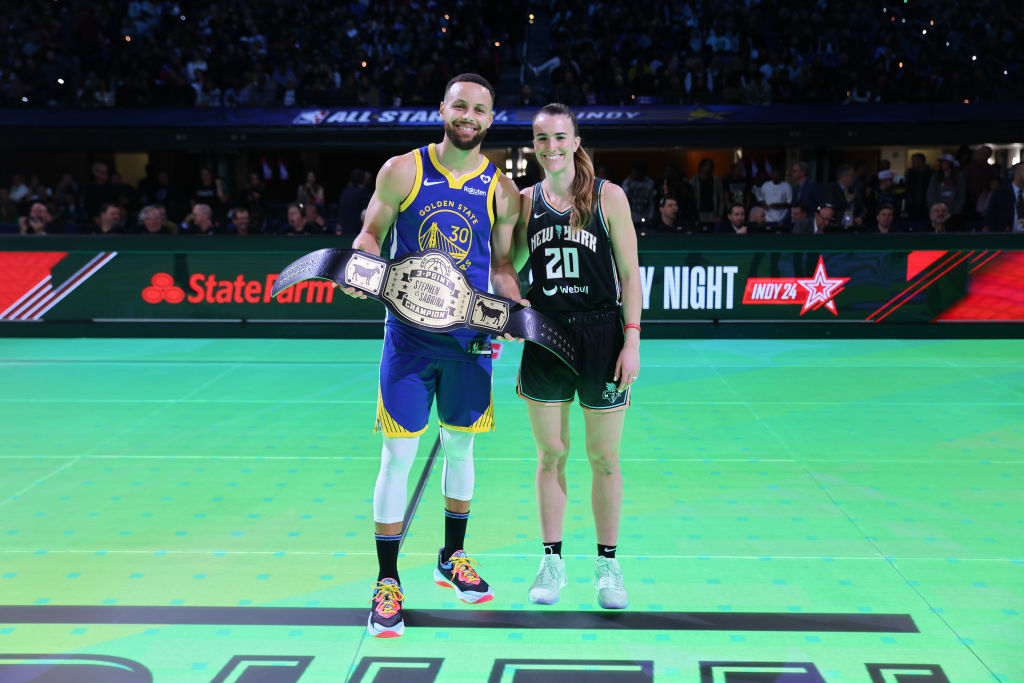
Succeeding at sport threatens the patriarchy.
Arriving at a time when right-wing lawmakers are using the idea of protecting women athletes for their own political goals, Open Play is much-needed food for thought. President Trump’s two-sex executive order barred the vanishingly small number of trans athletes in this country from participating in women’s sports. “Trans women are not dominating women’s sport at all,” says Mumford. “It’s a manufactured scare. It’s almost at the point where being good at sport is grounds to question someone’s gender because it challenges the perception of how a woman ‘should be.’ Succeeding at [sport] threatens the patriarchy.”
Consider, for instance, the case of Algerian boxer Imane Khelif, a cisgender woman who had her gender called into question during the 2024 Paris Olympics after her opponent forfeited, chargingthat Khelif’s punches were too hard. Or think of South African runner Caster Semenya, who was made to undergo sex verification testing in 2009. Sex testing in sports appears perennially throughout history, from the “nude parades” of the 1950s and ‘60s to chromosomal testing, which World Athletics just announced it would be reintroducing. “We’re starting to see the reemergence of the idea of ‘who is a real woman,’” says Bekker.
But ultimately, gender policing in sport isn’t just about politics—it’s also about money.
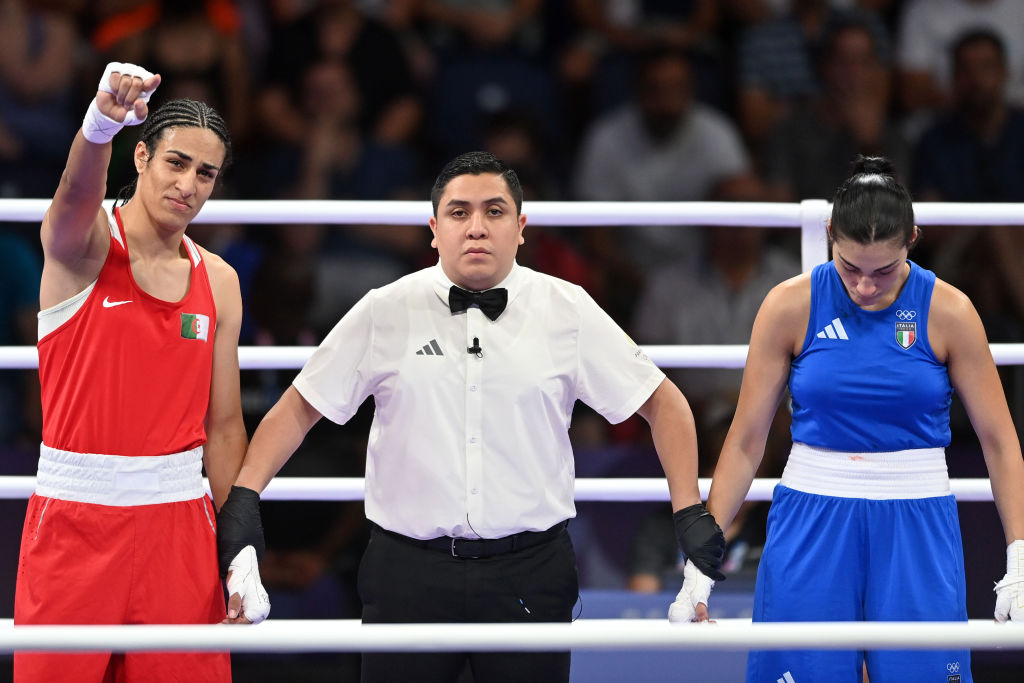
Women’s sports get a fraction of the funding, attention, and visibility that men’s sports do. Without sufficient funding, women are working with subpar facilities, which, as the U.S. Women’s National Team argued during their equal pay dispute, can shorten their careers. Under current women’s-league pay conditions, many women athletes also have to work full-time jobs to supplement their paychecks. While elite male athletes are restoring their bodies to squeeze another winning season onto their resume, women like Ilona Maher are running themselves ragged just to keep the lights on. A theory called the 10% gap, which Bekker and Mumford believe to be flawed, posits that men are roughly 10% stronger, faster, and better at sports than women. But “it’s not as if men’s sport is getting 10% more of the funding than women’s sport,” says Mumford. “It’s usually 90% of funding.” Imagine how much better women athletes could perform if they were given access to the degree of training and resources those dollars can buy.
So, would it work for fans? A modern-day Battle of the Sexes might feel like a feminist win, but the rising popularity and viewership of women’s sports could indicate that some people just aren’t interested in watching men compete, regardless of the gender of their opponent. I am a fan of professional wrestling, and while I’m a champion for intergender wrestling and have written about it widely, I still prefer to watch women’s wrestling only. So while a desegregated athletics landscape might be an ultimate goal—at least as an option—for the time being many competitors would likely choose to stay in their current categories.
Non-binary athletes might offer us a glimpse of a more inclusive future, though. USA Gymnastics doesn’t have a specific category for non-binary competitors, and Australian Athletics offers the option to compete in the binary category they feel most comfortable in. And many nonbinary athletes gravitate towards non-traditional sports like roller derby, in which play is often not sex-segregated.
“Non-binary people are showing us the way forward,” Bekker says. “Traditional sports organizations right now are not on top of this and they’re going to lose more people coming into their sport as younger generations, who are more diverse, grow up.”
In the meantime, we’ll have to content ourselves with sportswomen kicking ass in gendered categories—and waiting for the men to be just as interesting to watch.

Scarlett Harris is a culture critic, author of A Diva Was a Female Version of a Wrestler: An Abbreviated Herstory of World Wrestling Entertainment, and editor of The Women Of Jenji Kohan.
